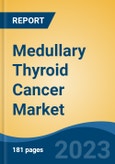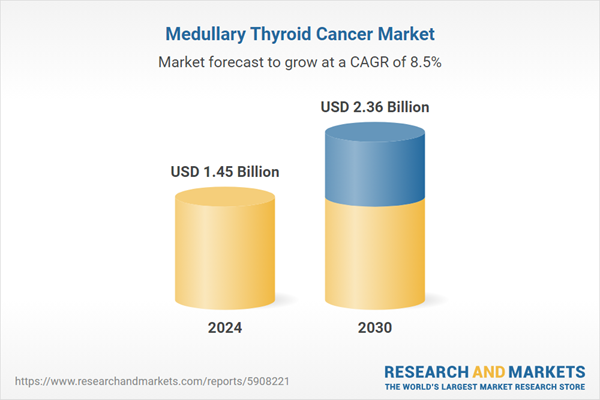Speak directly to the analyst to clarify any post sales queries you may have.
10% Free customizationThis report comes with 10% free customization, enabling you to add data that meets your specific business needs.
The Global Medullary Thyroid Cancer Market is witnessing steady growth, primarily driven by factors such as rising incidence rates, advancements in diagnostic technologies, evolving treatment modalities, and increasing awareness. While it represents a small segment of the overall cancer market, its unique characteristics and the pressing need for effective treatments make it an area of active research and development.
Key Market Drivers
Rising Prevalence of Thyroid Cancer
The rising prevalence of thyroid cancer is a significant driver of growth in the Global Medullary Thyroid Cancer (MTC) Market. In 2020, approximately 586,000 cases of thyroid cancer were recorded globally, positioning it as the 10th most prevalent cancer worldwide. The disease exhibited a significant gender disparity, with an estimated 449,000 cases in females compared to 137,000 cases in males, highlighting that thyroid cancer occurs at three times the rate in women relative to men. As more cases of thyroid cancer, including MTC, are diagnosed worldwide, the demand for diagnostic solutions, advanced treatments, and targeted therapies continues to rise.This increasing prevalence influences multiple market factors, from pharmaceutical innovation to healthcare infrastructure development, ultimately fueling market expansion. The growing incidence of thyroid cancer directly contributes to the demand for effective therapies, especially for rare subtypes like MTC. Medullary thyroid cancer (MTC) is a rare neuroendocrine malignancy, representing 1% to 5% of all diagnosed thyroid cancer cases, its unique clinical characteristics and aggressive nature necessitate specialized treatment approaches. Global thyroid cancer incidence has been steadily rising over the past two decades, partly due to improved screening programs. Studies show a higher detection rate of MTC cases, particularly in high-income countries with advanced healthcare infrastructure. As more patients are diagnosed with MTC, the market size for MTC-specific treatments expands. This encourages pharmaceutical companies to invest in drug development and clinical trials to meet the growing demand.
Key Market Challenges
High Treatment Costs
The cost of treating medullary thyroid cancer, particularly with advanced therapies and targeted medications, can be exorbitant. These high treatment costs pose a substantial challenge for patients, healthcare systems, and insurers. Patients may face financial strain, while healthcare providers may struggle to offer the latest treatments due to budget constraints. Additionally, insurers may impose restrictions on coverage for certain treatments.Limited access to cutting-edge therapies for patients without adequate insurance coverage. Healthcare providers may need to make difficult decisions regarding resource allocation. Financial burden on patients may lead to treatment non-compliance and adverse outcomes.
Key Market Trends
Advancements in Precision Medicine
Precision medicine is revolutionizing the approach to treating medullary thyroid cancer. This trend involves tailoring treatments to individual patients based on their specific genetic mutations and disease characteristics. As our understanding of the genetic underpinnings of medullary thyroid cancer deepens, more targeted therapies are being developed. These therapies aim to inhibit the specific molecular pathways driving cancer growth, resulting in more effective and less toxic treatments.Key Market Players
- AstraZeneca PLC
- Sanofi AG
- Eli Lilly and Company
- Exelixis, Inc.
- F. Hoffmann-La Roche Ltd
- Novartis AG
- Merck & Co., Inc
- Bayer AG
- HUTCHMED Ltd.
- Bristol-Myers Squibb Co.
Report Scope:
In this report, the Global Medullary Thyroid Cancer Market has been segmented into the following categories, in addition to the industry trends which have also been detailed below:Medullary Thyroid Cancer Market, By Treatment:
- Surgery
- Radiation Therapy
- Chemotherapy
Medullary Thyroid Cancer Market, By End-User:
- Hospitals
- Radiation Therapy Center
- Cancer Research Institutes
Medullary Thyroid Cancer Market, By Region:
- North America
- United States
- Canada
- Mexico
- Europe
- France
- United Kingdom
- Italy
- Germany
- Spain
- Asia-Pacific
- China
- India
- Japan
- Australia
- South Korea
- South America
- Brazil
- Argentina
- Colombia
- Middle East & Africa
- South Africa
- Saudi Arabia
- UAE
Competitive Landscape
Company Profiles: Detailed analysis of the major companies present in the Global Medullary Thyroid Cancer Market.Available Customizations:
With the given market data, the publisher offers customizations according to a company's specific needs. The following customization options are available for the report.Company Information
- Detailed analysis and profiling of additional market players (up to five).
This product will be delivered within 1-3 business days.
Table of Contents
Companies Mentioned
- AstraZeneca PLC
- Sanofi AG
- Eli Lilly and Company
- Exelixis, Inc.
- F. Hoffmann-La Roche Ltd
- Novartis AG
- Merck & Co., Inc
- Bayer AG
- HUTCHMED Ltd.
- Bristol-Myers Squibb Co.
Table Information
| Report Attribute | Details |
|---|---|
| No. of Pages | 183 |
| Published | March 2025 |
| Forecast Period | 2024 - 2030 |
| Estimated Market Value ( USD | $ 1.45 Billion |
| Forecasted Market Value ( USD | $ 2.36 Billion |
| Compound Annual Growth Rate | 8.4% |
| Regions Covered | Global |
| No. of Companies Mentioned | 10 |









